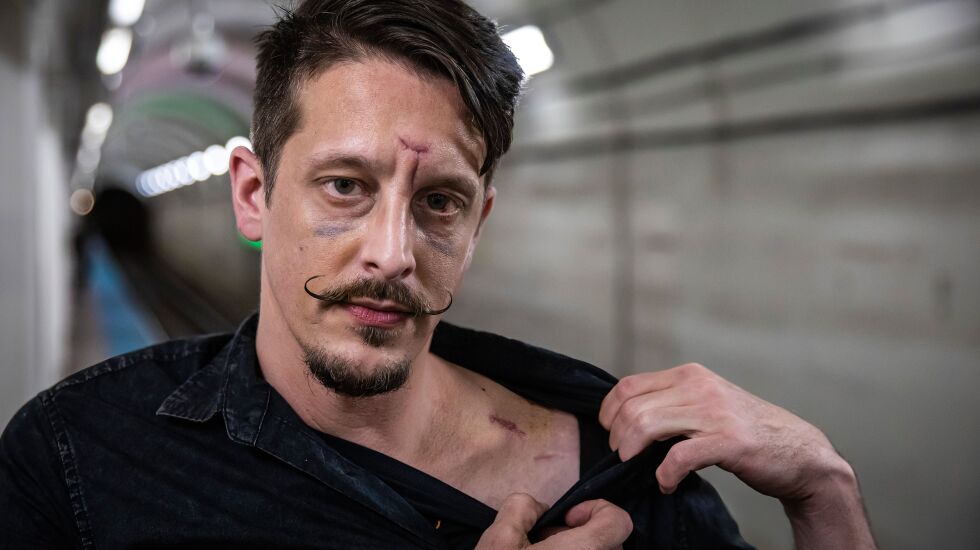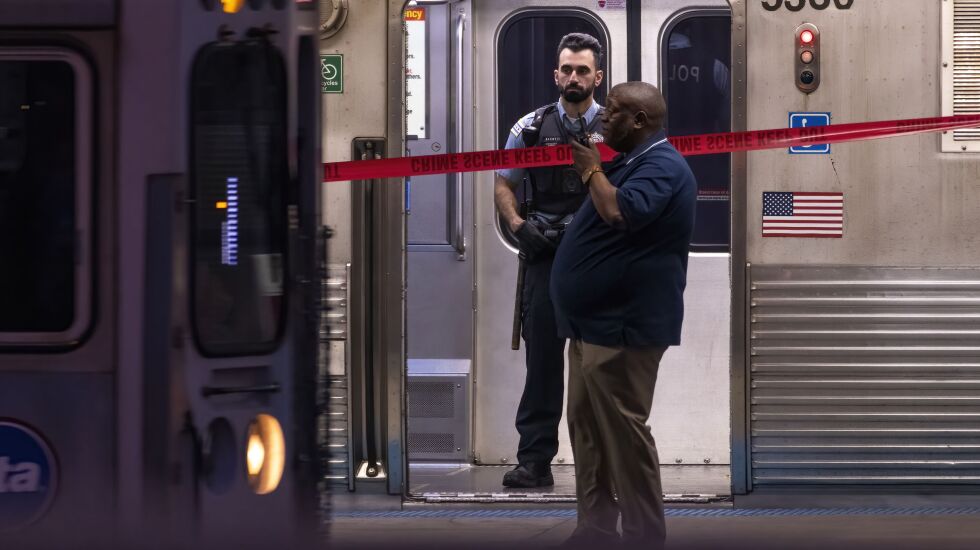They sized him up. Then, one of them grabbed his cellphone.
That set off a melee involving knives and bottles that put a spotlight on the sharp rise in violent crime on the CTA’s L and subway trains and buses — and the city’s struggling efforts to contain it.
Beam, 42, fought back and eventually got away, and his attackers were arrested.
But not before he was kicked in the face, stabbed in the collar bone and cracked over the head with bottles as he fended off the two men he was wary of and four others he and the police say also took part in the attack July 22.
It spilled onto another train car and the platform of the North/Clybourn station, with Beam knifing three of his attackers before jumping from the train and calling for help.
“There’s no doubt that I was victimized regardless of how the fight went [and] that I might have gotten a couple shots in,” Beam says. “It’s a traumatic experience. I can’t imagine other people who aren’t as aware or vigilant or prepared as I am being in that type of situation.”
The number of violent crimes on the L and buses has jumped to a level not seen in over a decade, a Chicago Sun-Times analysis has found. Through July 19, 488 attacks had been reported on the transit system — the most since 533 during the same period in 2011.
The number of passengers has remained relatively low since the COVID-19 pandemic hit. That means riders are more likely to fall victim to a violent crime today than they were a few years ago, according to the analysis, based on city crime data.
The city used to have a data portal online and available to the public that tracked each crime on the CTA but stopped updating that in 2011. The Sun-Times used other crime data to create a similar dataset for this analysis.
Violent crimes accounted for more than 26% of the 1,863 crimes reported on the CTA this year.
In 2018 and 2019, when there were far more riders, violent crimes amounted to 13% of the crimes.
As more violent crimes have been committed, the deployment of police officers on the CTA system hasn’t kept pace.
There are 145 officers assigned to the Chicago Police Department’s transit units, down 92 officers from a peak in April 2020. They are supplemented by more than 250 unarmed, private security guards.
Beam, a Chicagoan who runs a call center and manages the career of soul musician Adam Ness, says he was told he couldn’t sue the CTA to pay for his medical expenses. He has started a GoFundMe online fundraising campaign that has raised more than $3,000.
“We all know it’s unacceptable,” he says of the rise in violent crime on the CTA. “But the fact is the city isn’t doing anything about it. It most certainly seems like the people currently responsible for the situation are not doing an adequate job.”

More unarmed guards, more crime
This year began with the number of police officers patrolling the CTA having dropped to a near-five-year low.
The police department’s Public Transportation and Transit Security units had 138 officers patrolling the entire system in February, according to data compiled by the city’s inspector general’s office. That figure was the lowest since August 2017, which is the earliest that monthly data has been made available. This month has seen 145 officers assigned to those units.
By comparison, the Dallas Area Rapid Transit Police Department has more than 200 officers patrolling its system. It announced plans earlier this year to hire 65 more.
On March 9 — after a series of violent attacks — Mayor Lori Lightfoot and police Supt. David Brown held a news conference at the Chicago Avenue Red Line stop, where a group of teenagers had been beaten and robbed two people days earlier.
They announced plans to hire more unarmed guards and to shuffle police resources “to better address shifts in crime patterns” — measures criticized by a transit union chief who called on the agency to form its own police department, as Dallas, New York City and Atlanta have done.
Also at the news conference was Dorval Carter Jr., Lightfoot’s CTA board president, who tried to reassure riders at a time city officials were working to boost business and tourism still recovering from pandemic-induced shutdowns.
In 2019, the last year unaffected by the coronavirus, the CTA’s average number of monthly riders was nearly 38 million. Between June 2021 and this May, which is the last monthly data that’s available, fewer than half as many riders have used the public transit system each month.
“I want you to know that we are aware of how some of your riding experiences have changed and that we are committed to making it better,” Carter said in March.
But only six police officers have been added to the police transit units since March.
A rash of attacks last month reignited concerns about how safe the CTA is.
Three days after Beam was attacked, Darin Mcnair, 15, was stabbed to death when he and six other people tried to rob a man on a Red Line train near 63rd Street.
Cmdr. Joseph Bird of the Public Transportation Section says riders most often are targeted for snatch-and-grab robberies when a train is stopped at a station, with one robber holding the doors open, for instance, while a partner grabs a cellphone from someone’s hand and takes off.
The Public Transportation Section is essentially made up of uniformed beat cops. The smaller Transit Security Unit includes plainclothes officers, according to Bird. There also are a number of canine officers assigned to the system.
At a news conference Monday, Brown said additional officers from outside the department’s transit units are now being tapped to shore up the CTA coverage.
Assigning cops to these “tiered deployments” has become a necessity for a department struggling to retain and recruit members. Officers have had days off canceled and been sent to work in unfamiliar surroundings, including in high-crime areas.
Police officials aim to have 131 police officers a day working on the transit system, according to Brown, who said new recruits will be assigned to the CTA units.
“All the neighborhoods need more people, too,” he said. “So it’s just not a one-off thing. If it were just the CTA, it would be much easier to solve.”
Brian McDermott, the police department’s chief of patrol, says officers under his command are required to check train stations on their beat every shift. Also, district commanders conduct roll calls at CTA platforms, and patrol officers carry out drills to check response times on the CTA, according to McDermott.
Bird says the police pass out cards at community meetings to solicit tips and work with CTA employees to coordinate deployments and “identify what they’re seeing.”
The CTA’s 32,000 cameras also serve as a crime-fighting tool, according to Bird, who says the department uses them to build cases. He and Hosinski point to the attack on Beam as a case in which the cameras were crucial to identifying the suspects.
Six people were arrested, and five were charged with felonies. All have prior convictions, including Vernon Holman, 52, a five-time felon and convicted murderer who was stabbed during the botched robbery.
The CTA has more than 250 unarmed guards assigned to the system, and officials say they hope to add about another 50, though the agency is struggling to fill vacancies, as are many transit agencies around the country.
The Amalgamated Transit Union Local 308, which represents some CTA employees, has lobbied to bring back conductors, who were pulled off trains starting in 1997. The union also has called for the reestablishment of the CTA’s own police department, which was disbanded in 1980.
Hosinski says doing so would take several years and cost hundreds of millions of dollars.
“This partnership with CPD provides CTA the support of other policing resources, like detectives and the Strategic Decision Support Center, which CPD launched in 2020, featuring smart-policing technology and full connectivity to CTA’s extensive security-camera network,” Hosinski says. “Further, this partnership not only benefits CTA riders but the city as a whole, something that cannot be achieved with an independent policing unit.”
Even before the pandemic upended normal life, Chicago city officials were having a hard time making the transit system safer. In late January 2020, just a week after the city’s first coronavirus case was confirmed, Lightfoot called what was then a three-year surge in CTA crime “totally, fundamentally unacceptable” and promised to get a handle on it.
After asking SWAT officers to start riding trains, interim police Supt. Charlie Beck announced plans for a crackdown that February. He added more transit cops, assigned four detectives to solve CTA crimes and built a strategic deployment center specifically for mass transit.
Bolstered by 50 moonlighting officers paid by the CTA, the number of cops assigned to transit units grew from 187 that month to 237 in April 2020 — the most in recent years.
But then ridership fell significantly, Lightfoot brought in Brown to head the police department, and he began thinning the ranks of those units.

Not just the CTA’s problem, advocate says
Julia Gerasimenko, advocacy manager for the Active Transportation Alliance, says the safety of public transit shouldn’t fall solely on CTA but should be addressed by other governmental agencies as well.
“When it comes to crime on the CTA, it is not like CTA is somehow immune from other societal ills in this city,” Gerasimenko says. “Other city agencies need to step up, and we need political will that doesn’t only fund public safety but also increases funding for social services, public health and bolsters other safety-net programs.”
Gerasimenko says the introduction of more unarmed security guards at the CTA’s train stations is puzzling because there’s little evidence they make any difference.
Rather than spend $71 million on private security — with no oversight for the training of guards and no one looking at whether they’re effective — she suggests as an alternative making an investment in “transit ambassadors” who would work as conductors but wouldn’t be unionized.
“Frankly, we are not seeing these unarmed security guards resolve any conflict other than kicking unhoused people off a train,” Gerasimenko says. “They are not seen at platforms where violent crime is happening. They are not trained in de-escalation or even customer service.”







